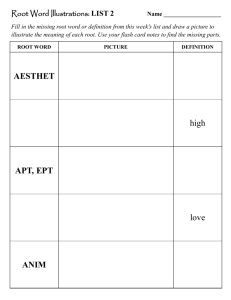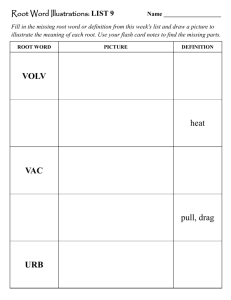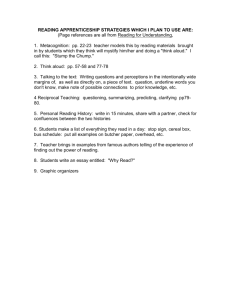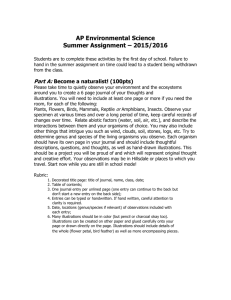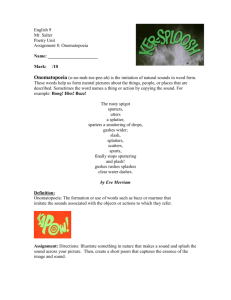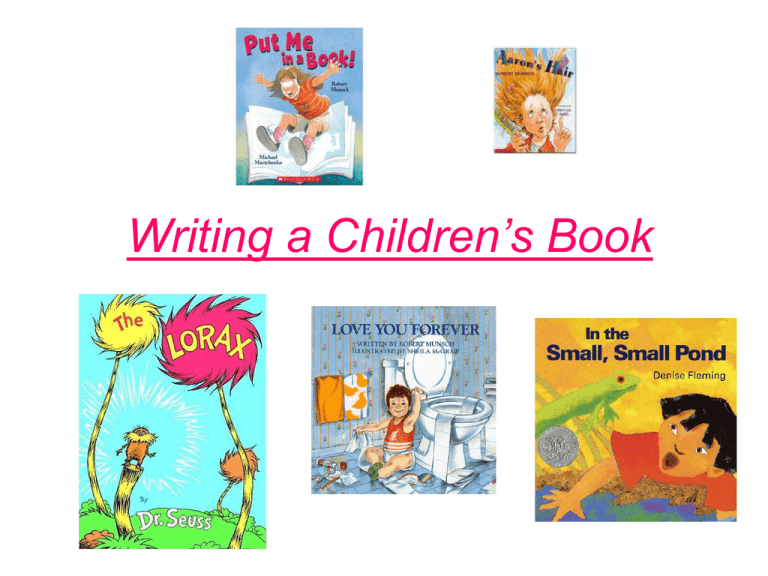
Writing a Children’s Book
TOP 10 reasons to share picture books with
ALL ages!
10. Universal Themes = Universal Appeal
9. Wonderful Art = Increased Artistic Appreciation
8. Models of Excellence = Better Writers
7. Visual/Verbal Connections = Successful Readers/Learners
6. Succinct/Rich Language = Increased Vocabulary
5. Sharing A Book = Common Prior Knowledge
4. Varied Maturity Levels = Enjoyment On Multiple Levels
3. Pictures and Words = Increased Understanding Of Concepts
2. Words and Pictures = Powerful Emotional Impact
1. Love Of Picture Books = Lifelong Love of Learning/Reading
1. Listen
(Robert Munch)
http://robertmunch.com/books/
•
Each student will need a file folder & 2 pieces
of paper!
- On one sheet of paper, write the title: What I
notice? (example: lots of colour)
- On the second sheet, write the title: Ideas!
(as you read, what ideas can you think of to
include in your story?)
Take a Look!
• With a partner, read one Robert Munsch
children’s story!
– As you read, write down what you notice and ideas
you think of to use in your own children’s story
– Take turns writing what you noticed on chart paper at
the front of the room!
• Online Children’s Books/Stories
• http://www.storylineonline.net/
(read by
celebrities w/ activities)
• http://www.magickeys.com/books/
• http://wiredforbooks.org/kids.htm
• http://pbskids.org/clifford/stories/index.html (with story
builder – IPP)
• http://www.tumblebooks.com/library/asp/home_tumblebo
oks.asp
• http://www.tumblebooks.com/library/asp/customer_login.
asp?accessdenied=%2Flibrary%2Fasp%2Fhome%5Ftu
mblebooks%2Easp
• http://www.biguniverse.com/readkidsbooks
1. Children’s Story Project Outline
2. Writing Picture Books for Children
handout
3. Big Fox Graphic Organizer
4. With a partner, read a new children’s
book, fill in “Big Fox” and add to “What
did I Notice?” and “Ideas!”
Using Rhyme
Read aloud:
– Green Eggs and Ham
– A PIG’S TALE
How might rhyming be difficult?
Listen:
http://www.inklesstales.com/stories/
Using Onomatopoeia
What is onomatopoeia?
– Words that sound like what they are!
Example: “Pop!”
Read Aloud: The Librarian from the Black Lagoon
Listen: Mr Brown Can Moo, Can You?
http://www.youtube.com/watch?v=npU4tcd4Do8
Writing Picture Books for Children
Elements of a Good Story
• Elements of a Good Story
• Even though picture books are short they still
need to contain all the usual elements of a good
story - a main character that readers can identify
with and care about and a conflict that needs to
be resolved by the end of the story. All picture
books have a happy, satisfying ending.
• The conflict of a picture book must be something
that children of the targeted age group have
experience with and therefore understand. It
should also be something that interests them.
What Goes in the Illustrations?
• A general rule is that whatever appears in the
illustrations doesn't need to be mentioned in the text.
Firstly, you don't have to describe your characters in a
picture book. The reader can see what the characters
look like from the illustrations. Secondly, you don't need
to describe your settings because they also appear in
the illustrations.
• Adults read picture books aloud to children. It is
important that your story reads well aloud, that it has a
lovely flow and rhythm. Hence, sentences should be
short and easy to understand. Repetition of a sentence
(or sentences) is popular in picture books as it adds to
the rhythm and children enjoy joining in.10
The Importance of Language in
Picture Books
• As you are working with a limited number of words, every word is
vital. You should consider every word and make sure that it is
necessary. You should also ask yourself if the words you are using
are the best choices .Are they appropriate for the age group?
Consider things like sound, meaning, interest, tension, page-turning
• I've heard many publishers suggest that writers of picture books
avoid writing in rhyme. They say that it is extremely difficult to do
well. The majority of rhyme-texts they receive simply don't work and
thus are unpublishable.
• Many kids like onamatoepia – that is, words that sound like what
they are. A very simple one everyone knows is “pop!” Words that are
fun to say are great. Dr. Seuss makes up words that sre completely
silly and don’t mean anything, but they make us laugh. Many times
he succeeds in conveying an important message in a childlike
manner. I love the line “A person’s a person no matter how small.”
By Horton the Elephant in “Horton hears a Who.”
What do you write about?
• Write about something that interests you,
that fires your imagination. If you’re bored
with what you’re writing how can you hope
to excite anyone else?
Children’s Books: Cover to Cover!
What do we see?
1. The Front Cover
•TITLE
•PICTURE
•AUTHOR
•ILLUSTRATOR
2. The Inside Front Cover
• Copyright (2010) All rights reserved
• Publisher (you and the address)
• ISBN #
• Optional: a dedication and/or other books by the
same author
3. The Title Page
• Author
• Illustrator
• a Picture
4. The Inside Back Cover
Jim Bob is a grade 7 student at Madeline
Symonds Middle School in Hammonds Plains,
Nova Scotia, Canada. Jim Bob, an enthusiastic
athlete, has been a sports buff his entire life, which
is why he chose to write a story about basketball!
He lives in Hammonds Plains with his parents and
sister. This is his first children’s book.
• About the Author
• A picture of the Author
How to Write: About the Author
Start with a Tag Line: Jim Bob is a grade 7 student at Madeline Symonds
Middle School in Hammonds Plains, Nova Scotia, Canada. (A Tag Line is
much like a headline but introduces you, what you do, and where you live all
in one sentence)
The Bio: Jim Bob, an enthusiastic athlete, has been a sports buff his entire life!
He lives in Hammonds Plains with his parents and sister. This is his first
children’s book.
Always write your biography in third person so it sounds as though someone
else wrote it. If this is difficult for you, you can ask someone else to help
you!
It should be short and sweet!
5. The Back Cover
• Summary of book
• At the bottom: publisher, ISBN #, bar code,
picture, price
6. The Spine
• Title
• Author
How to: Peer-Edit
• Check SPELLING! (ex: watch there/their, etc. *use a
dictionary!*)
• Check TENSE! (if the book uses “is” and “are” it cannot switch
to “was” and “were” part way through!)
• Does it MAKE SENSE?
• Does it F-L-O-W?
• Complete “Peer: 2 Stars, a Wonder and a Wish”
worksheet
Before You Leave Today…
• Your ‘What we notice’ sheet should have
examples of onomatopoeia & rhyming
• You should have your main character (s)
selected (a sketch) –use coloring books for
ideas
• You should have a brainstorm/jot notes of your
main idea or conflict
Organize Your Thoughts!
• Graphic Organizer for Children’s Book
• Episodic Notes
Graphic Organizer for Children’s Books
Main Character: ___________________________________________
Description: ______________________________________________
Traits & Abilities:
______________________________________________________________________________
______________________________________________________________________________
Other Characters:
______________________________________________________________________________
______________________________________________________________________________
Setting: __________________________________________________
Place: ___________________ Time: __________________
Plot:
______________________________________________________________________________
______________________________________________________________________________
_______________
Events:
1. ______________________________________________________
2. ______________________________________________________
3. ______________________________________________________
4. ______________________________________________________
Resolution and/or Moral (Lesson Learned):
______________________________________________________________________________
Episodic Notes
• Remember you will complete 30 boxes
– 28 pages + a cover and back cover
Episodic Notes
Name ______________________________________ Date _________________
Topic ______________________________________ Period ________________
Purpose: lay out your story; organize your pages .
Determine the most crucial stages, scenes or moments in the story or process.
Draw in the box what happens and what you ?see? in the text. Be as specific as possible.
Remember these are notes, not works of art: try to capture the action and important details of the
moment.
Explain (in the notes section under the box) what is happening or writing your story line.
______________________
______________________
______________________
______________________
______________________
______________________
______________________
___________________________
___________________________
___________________________
___________________________
___________________________
___________________________
___________________________
_________________________
_________________________
_________________________
_________________________
_________________________
_________________________
_________________________
Now what?
1. After you have finished your episodic
notes, begin your rough draft on the
paper booklet provided!
2. After you complete your rough draft, find
a partner to PEER-EDIT (spelling,
grammar, etc.) and complete Peer: 2
Stars a Wonder and a Wish worksheet
(peer-conference)
Wrap it up!
Once you have completed your rough draft,
Peer: 2 Stars a Wonder and a Wish, and have
made any necessary changes……
Start your FINAL COPY (on the hard cover book
provided!)
Book Launch

